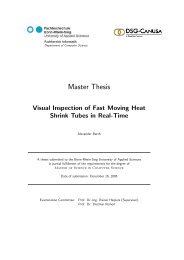Master Thesis - Hochschule Bonn-Rhein-Sieg
Master Thesis - Hochschule Bonn-Rhein-Sieg
Master Thesis - Hochschule Bonn-Rhein-Sieg
Create successful ePaper yourself
Turn your PDF publications into a flip-book with our unique Google optimized e-Paper software.
5. Algorithms <strong>Master</strong> <strong>Thesis</strong> Björn Ostermann page 63 of 126<br />
To redistribute the values a probability distribution function (PDiF) is calculated. The PDiF, as shown<br />
in Figure 39c, is created by adding the amount of all pixels with lower intensity to each amounts of<br />
pixels (see formula in Equation 4).<br />
PDiF<br />
pixels<br />
n<br />
�<br />
i�0<br />
�n�� Number _ of _ pixels�i�<br />
Equation 4: Formula to calculate the PDiF<br />
PDiFpixels �n��Amount of all pixels with an intensity value equal or lower than n<br />
��� i<br />
Number _ of _ pixels Amount of pixels with the intensity value i<br />
Based on this PDiF the intensity value of each pixel is changed by a mapping function, shown in<br />
Equation 5. This function changes the width of the intensity values, to match their respective heights.<br />
This results in the values being centred on a straight line (Figure 39d).<br />
newIllumVa lue<br />
� PDiFpixels<br />
� IllumRange �<br />
�<br />
�<br />
� Number<br />
�IllumValue�� �<br />
�<br />
Values<br />
Equation 5: Intensity value redistribution function<br />
newIllumVa lue � New intensity value of all pixels that have the old value<br />
IllumRange � Size of the complete range of intensity values<br />
PDiFpixels �IllumValue��see Equation 4<br />
IllumValue � Old intensity Value of a pixel<br />
Number � Number of different intensity values<br />
Values<br />
In the resulting intensity distribution, shown in Figure 39e, the intensity values are spaced evenly<br />
throughout the image. As can be seen from the result, due to the missing information behind the<br />
decimal point some previously separated values are compressed in a single value. This loss of<br />
information is not important to the normal observer, who is not trained to distinguish 65536 different<br />
greyscale values. In this project the reflection image was only used for depicting the information to the<br />
user.<br />
The visual improvement of the resulting image can be observed in Figure 40, which shows a sample<br />
office environment with different materials present, including metallic objects with high reflectivity<br />
and dully lacquered materials with low reflectivity.<br />
�














